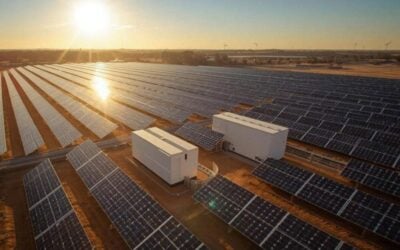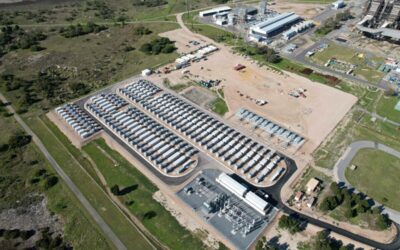The report’s authors include UK solar developer Lightsource, with research co-ordinated by KPMG. Image: Lightsource.
The UK government could deliver cheaper electricity bills to households and businesses by pursuing a decentralised energy strategy with solar and storage at its centre, a new report co-ordinated by major consultancy group KPMG has claimed.
‘The Decentralised Energy Transition’ report has been co-authored by UK solar developer Lightsource Renewable Energy, solar investment group Foresight Solar and renewable energy generator and utility Good Energy. Research was co-ordinated by KPMG, one of the global Big Four professional services groups and inputs from global technology giant Tesla and UK Power Networks, one of Britain’s electricity distribution network operators (DNOs).
The wide-ranging report proposes a future strategy at government level which it claims would help the UK meet several energy market dilemmas by reallocating funding for solar currently available under the country’s Levy Control Framework government budget for energy, and not exceeding it.
The UK government Department of Energy and Climate Change (DECC) decided in July to review support schemes for renewables. Proposed cuts could take as much as 87% off the value of small-scale solar feed-in tariffs, while the country’s large-scale solar sector is grinding to a halt due to the end of other programmes including Renewable Obligation Certificates (ROCs).
Try Premium for just $1
- Full premium access for the first month at only $1
- Converts to an annual rate after 30 days unless cancelled
- Cancel anytime during the trial period
Premium Benefits
- Expert industry analysis and interviews
- Digital access to PV Tech Power journal
- Exclusive event discounts
Or get the full Premium subscription right away
Or continue reading this article for free
The latest report comes just two days before a consultation deadline for the feed-in tariff changes and also follows on the heels of last month’s reports from electricity market regulator Ofgem. One of these was based around recommendations for increasing the flexibility of the network, with storage playing a central role, and was welcomed by solar and storage groups. Another looked at allowing “non-traditional” business models to participate in electricity markets – which included allowing aggregated energy storage installed by households and community groups to provide services to the grid, essentially reconfiguring the role of the DNOs to distribution service operators (DSOs), in other words hosting the platforms that allow for energy trading and other flexibility mechanisms such as demand response.
Time-limited storage incentives
The decentralisation report’s main recommendations consist of a re-working of future feed-in tariffs for solar and a time-limited incentive for households to purchase domestic storage solutions. Its feed-in tariff recommendations offer a significant increase on those currently proposed by DECC for next year, but includes them ending in 2019/2020, a year earlier than DECC has envisaged.
These tariffs would be combined with a time-limited deployment “grant” for storage, similar to the scheme introduced in Germany, which would comprise a one-off payment for discharge capacity made available to residential customers. Deployment grants would be capped at £1,500 per customer, with an overall total spend up to 2020 of no more than circa £300 million. The report states that funding for this programme would be found by re-directing existing innovation funding from both UK and EU innovation funding sources.
The report does however state that these measures would have to be supported by the introduction of time-of-use tariffs and half-hourly metering for domestic customers by 2018/19, to allow them to benefit from more economical rates and the UK to address grid management issues.
In addition, DNOs and transmission system operators (TSOs) would have to be incentivised to support more widespread deployment of decentralised energy, which the report says could be achieved with a regulatory mechanism that would allow them to own and operate energy storage as a regulated network asset.
If self-consumption of PV-generated power increases as a result of the incentivised growth of storage, the report estimates that the amount required to support 1.1GW of residential PV over the period of the tariffs would fall in line with DECC’s statement within its recent FiT consultation that a maximum of £100 million of additional expenditure is available until 2018/19.
The report goes on to state that the longer-term effects would be a significantly lower LCF in the 2020s than DECC currently forecasts – currently £15 billion per year by 2025 – owing to increased self-generation and a lesser need for large-scale deployment.
Grid reinforcement
Central to the report’s argument is the government’s need to significantly reinforce the national grid if the UK is to meet DECC’s forecasts for required large-scale energy deployment by 2035. Of the 100GW required, 47GW is expected to come from renewables.
National Grid currently expects to spend some £882 million on system balancing costs this year alone, a figure which the report expects to fall dramatically if storage technologies with two-way flow of energy (bi-directional) enabled were to be more widely deployed.
According to Dr Jill Cainey, an expert with the UK Electricity Storage Network, National Grid has marked policy and regulatory barriers to energy storage’s value being recognised with a ‘red flag’ in its Future Energy Scenarios documents. The annual documents lay out plans for maintaining the network, with a red flag meaning that immediate or near-term actions are recommended.
Another central theme in the new report is the creation of “whole house” solutions or “smart homes”, which would combine solar PV installations with storage, hot water heaters and smart grids to create a more comprehensive energy efficiency product. Data compiled by Lightsource demonstrates that while more traditional PV solutions meet 20-35% of a regular household’s energy demand, a “whole house” solution would meet 60-90%.
Additional reporting by Andy Colthorpe.





